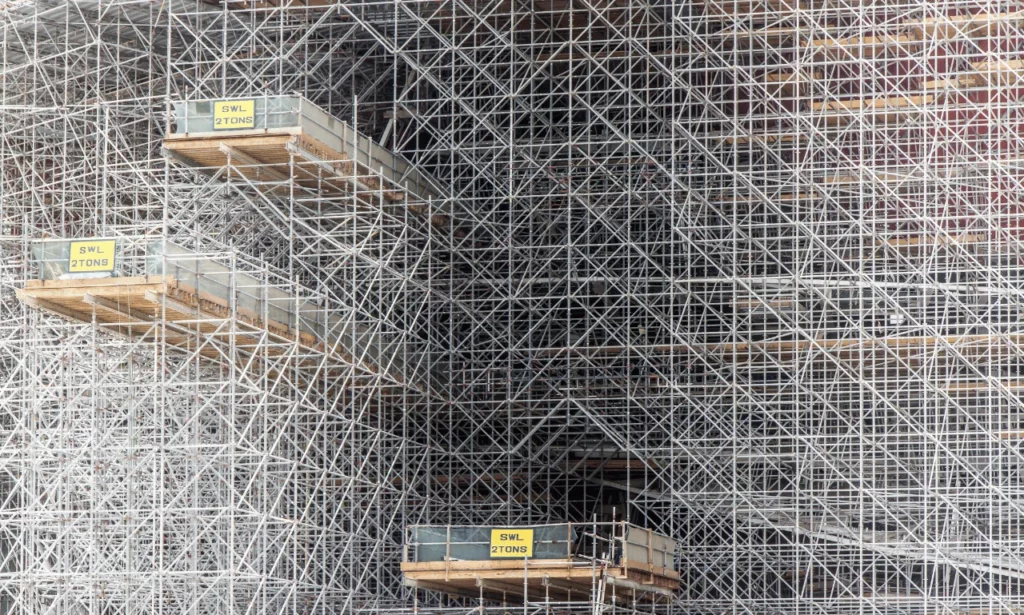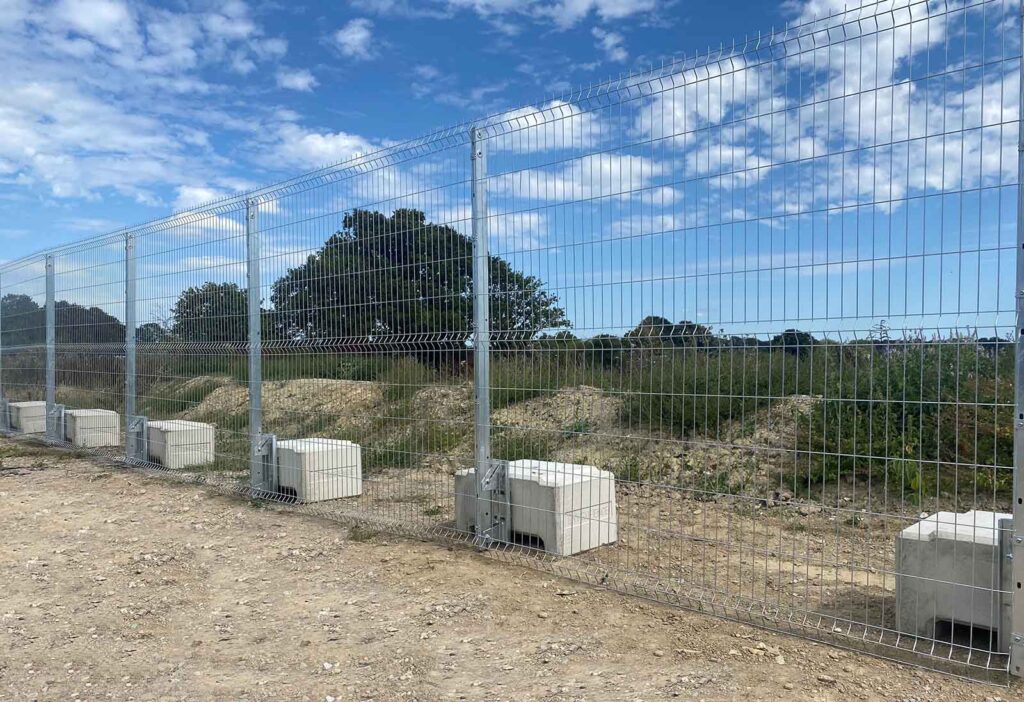Temporary scaffolding with site mesh is an essential part of modern construction practices. It provides crucial support and protection during building projects. This combination creates a strong system where metal frameworks hold up workers and materials, while mesh barriers establish important safety boundaries.
Construction sites face many challenges that require thorough safety measures:
- Physical Protection: Site mesh acts as a protective barrier, containing debris and preventing unauthorized access
- Environmental Control: The mesh system helps manage dust dispersion and reduces noise pollution
- Workplace Safety: Scaffolding equipped with proper mesh creates secure elevated work platforms
- Site Security: Integrated mesh solutions safeguard equipment and materials from theft or vandalism
The construction industry is constantly evolving with stricter safety regulations and environmental standards. Temporary scaffolding with site mesh meets these requirements while also providing additional benefits for project efficiency and site management.
This article explores the key advantages of using temporary scaffolding with site mesh, looking at its impact on safety, security, environmental protection, and cost-effectiveness in construction projects.

1. Improved Safety Measures with Scaffold Debris Netting
Scaffold debris netting is an important safety feature in construction areas that are elevated. It acts as a barrier to protect against objects and materials falling from above. This vital safety element makes dangerous work environments safer by adding multiple layers of protection.
Key Safety Features of Scaffold Debris Netting:
- The netting is made with a dense mesh material that can catch small particles and debris.
- It has a high-tensile strength that prevents it from tearing when something hits it.
- The materials used are UV-stabilised, so they won’t get damaged by sunlight.
- The edges of the netting are reinforced to withstand strong winds.
- There are multiple points where the netting is attached to ensure it stays securely in place.
Using temporary scaffold debris netting can greatly reduce accidents at the workplace by providing a complete system of protection. Construction sites that have properly installed netting report up to 95% fewer incidents of falling debris.
Areas Protected by Debris Netting:
- Primary Catch Zone – directly below where work is being done
- Secondary Containment – next to the scaffolding
- Ground-Level Safety Zone – protecting areas where people walk
- Vertical Barrier – stopping debris from spreading sideways
To make sure the scaffold debris netting works as best as it can, it’s important to install it correctly. When putting up the netting panels, they should be placed in a way that creates overlapping areas of protection. This will prevent any gaps where materials could slip through. The design of the netting also allows natural light to come through while still being able to contain debris effectively.
Safety Considerations Based on Height:
- Low-Rise (1-3 stories): Use standard mesh density
- Mid-Rise (4-10 stories): Reinforce attachment points
- High-Rise (10+ stories): Implement double-layer systems
- Special Zones: Use impact-resistant grades
By combining scaffold debris netting with other safety measures, we can create even better systems of protection. It’s important to regularly inspect these systems to make sure they continue to work well throughout different stages of construction. This includes making adjustments based on changes in site conditions and work requirements.
2. Strengthened Site Security through Temporary Fencing Solutions
Construction site security is crucial in project management. It protects valuable equipment and materials while ensuring workplace safety. Temporary fencing solutions provide a strong physical barrier that prevents unauthorised access and potential vandalism.
Learn more on: How Mesh Fencing Helps Secure Construction Zones Safely
Key Security Features of Temporary Fencing:
- Heavy-duty mesh panels with anti-climb properties
- Secure interlocking systems between fence sections
- Stabilising feet for uneven terrain
- Multiple access points with lockable gates
- Height options ranging from 1.8m to 2.4m
The choice of temporary fencing depends on the specific needs of the site and the results of risk assessments. High-security areas may require additional features such as:
- Anti-tamper brackets
- Concrete barrier blocks
- CCTV mounting points
- Razor wire extensions
- Security lighting integration
Modern temporary fencing solutions are designed to be modular, allowing for quick installation and reconfiguration as construction progresses. These systems can adapt to changing site layouts while still maintaining a consistent level of security throughout the project.
- Regular perimeter inspections
- Clear signage displaying access restrictions
- Designated entry/exit points for workers
- Visitor registration protocols
- Emergency access considerations
Using temporary fencing solutions can lead to lower insurance premiums and reduced compliance risks. These systems work alongside scaffold mesh to create a complete security envelope around the site, protecting assets and ensuring project timelines are met by preventing unauthorised interference.
For a more comprehensive understanding of effective site security measures, refer to this construction site security guide.
3. Environmental Protection Benefits with Dust and Debris Control Measures
Construction activities generate significant amounts of dust and debris, creating potential hazards for both the environment and nearby communities. Site mesh integrated with temporary scaffolding serves as an effective barrier against these environmental challenges.
Dust Control Capabilities:
- Creates a physical barrier preventing airborne particles from spreading
- Reduces the impact of construction dust on neighbouring properties
- Minimises respiratory risks for workers and local residents
- Helps maintain air quality standards in urban construction zones
The strategic placement of site mesh around scaffolding structures provides comprehensive dust containment, particularly beneficial during demolition phases or when handling fine particulate materials. The implementation of proper dust control measures through site mesh contributes significantly to environmental compliance and sustainable construction practices, helping construction companies meet local council requirements while demonstrating commitment to environmental stewardship.
Debris Management Benefits:
- Captures falling debris before it reaches ground level
- Prevents cross-contamination between different work zones
- Protects surrounding vegetation from construction waste
- Reduces clean-up time and associated costs
Site mesh systems also play a crucial role in weather protection:
- Blocks wind-blown debris from entering or leaving the site
- Contains water spray during pressure washing activities
- Prevents contaminated runoff from affecting local waterways
- Maintains cleaner site conditions during adverse weather
Modern site mesh materials feature specific weave patterns designed to optimise dust filtration while maintaining adequate airflow. This balance ensures effective environmental protection without compromising worksite ventilation or visibility.
Moreover, these construction site best management practices not only help in mitigating dust and debris but also provide comprehensive strategies for overall environmental protection during construction activities.
4. Cost-Effectiveness and Versatility of Lightweight Materials Used in Temporary Scaffolding Mesh
Modern lightweight scaffolding mesh materials deliver substantial cost benefits through reduced labour requirements and transportation expenses. These innovative materials weigh up to 40% less than traditional options while maintaining robust structural integrity.
Key Cost Benefits:
- Reduced transportation costs due to lighter loads
- Decreased labour hours for installation and dismantling
- Lower storage space requirements
- Minimised wear on handling equipment
- Extended material lifespan through easier handling
The versatility of lightweight mesh extends beyond basic cost savings. These materials adapt seamlessly to diverse project requirements:
Adaptable Applications:
- Quick reconfiguration for changing project needs
- Easy customisation for different surface areas
- Flexible installation around complex architectural features
- Simple integration with existing scaffolding systems
- Efficient stacking and storage between uses
The lightweight nature of modern mesh materials enables rapid deployment and removal, reducing project timelines and associated labour costs. A standard team can cover up to 30% more area per day compared to traditional heavy materials.
Installation Advantages:
- Single-person handling capabilities
- Reduced physical strain on workers
- Faster elevation to height
- Simplified adjustment procedures
- Streamlined replacement process
The combination of durability and lightweight properties creates an optimal balance between performance and practicality. Construction sites benefit from materials that maintain strength while offering superior handling characteristics, leading to improved project efficiency and reduced operational costs.
5. Durability and Weather Resistance Provided by High-Quality Site Mesh Materials
High-quality site mesh materials are incredibly durable and can withstand different weather conditions, making them essential for construction projects. These materials go through extensive testing to ensure they remain strong and intact despite various environmental challenges.
Key Weather-Resistant Properties:
- UV Protection – Advanced UV stabilisation prevents degradation and colour fading under intense sunlight
- Wind Resistance – Reinforced edges and strategic perforation patterns minimise wind load stress
- Water Repellent – Specialised coating prevents water absorption and resists mould growth
- Temperature Adaptable – Maintains flexibility and strength in both extreme heat and cold
The durability of premium site mesh goes beyond just basic weather protection. These materials are designed with tear-resistant weaves and anti-rip technology, creating a strong barrier that can endure daily construction activities.
Structural Performance Features:
- Reinforced eyelets at strategic points prevent tearing under tension
- Double-stitched edges provide additional strength at critical stress points
- High-density polyethylene composition resists chemical exposure
- Multi-layer construction enhances longevity and performance
Australian construction standards require site mesh to remain effective through multiple seasons. Quality materials meet these requirements by:
- Resisting salt spray in coastal environments
- Protecting against freeze-thaw cycles
- Withstanding heavy rain without sagging
- Maintaining tensile strength under prolonged sun exposure
The combination of these weather-resistant properties ensures continuous site protection, reducing the need for replacements and upholding safety standards throughout the project lifecycle.
6. Compliance with Safety Regulations Ensured through Flame-Retardant Grades for High-Risk Environments
Construction site safety regulations require the use of specific fire-resistant materials to protect workers and assets in high-risk areas. Flame-retardant scaffolding mesh plays a crucial role in ensuring safety, as it meets strict Australian Standards for fire safety compliance.
Key Safety Features of Flame-Retardant Mesh:
- Self-extinguishing properties prevent fire spread
- Reduced smoke emission during exposure to heat
- Maintains structural integrity under high temperatures
- Certified compliance with AS 1530.2 fire testing standards
High-risk construction environments require additional measures to protect against fire hazards. These areas include:
- Welding zones
- Electrical installation spaces
- Chemical storage facilities
- Areas with flammable materials
- Hot work operation sites
The use of flame-retardant mesh provides multiple layers of protection:
- Active Fire Prevention:Blocks sparks from welding operations
- Contains potential fire outbreaks
- Reduces risk of ember transmission
- Passive Safety Benefits:Creates fire-resistant barriers between work zones
- Protects evacuation routes
- Shields combustible materials from heat sources
Proper installation of flame-retardant mesh by professionals is essential to ensure its effectiveness. This involves applying the right amount of tension and securely attaching the mesh to scaffolding structures. Regular inspections are also necessary to confirm that the mesh retains its protective qualities throughout the duration of the project. It is important to keep records of safety compliance, including fire-resistance certificates, on-site for regulatory audits.
When selecting flame-retardant grades, it is important to consider the specific requirements of the project and conduct risk assessments. Higher-grade materials provide longer-lasting protection in extreme conditions, while standard grades are suitable for general construction purposes.
7. Branding Opportunities and Promotional Possibilities Utilised through Custom Colour Printing on Scaffolding Mesh Covers or Banners
Construction sites offer unique advertising spaces through custom-printed scaffolding mesh covers and banners. These large vertical surfaces turn construction areas into valuable marketing assets.
Strategic Marketing Benefits:
- Brand visibility across large urban areas
- Cost-effective advertising compared to traditional billboards
- Extended exposure throughout the project duration
- Multiple viewing angles for maximum impact
Custom colour printing on scaffolding mesh creates professional site appearances while delivering targeted messages. High-quality mesh materials can be printed using various techniques, allowing for:
- Company logos and branding elements
- Project completion dates
- Development visualisations
- Safety announcements
- Community engagement messages
The custom colour printing on scaffolding mesh not only enhances branding but also creates professional site appearances while delivering targeted messages.
Design Considerations for Maximum Impact:
- Bold typography for long-distance visibility
- Weather-resistant inks for durability
- Strategic placement of key messages
- Colour schemes matching brand guidelines
The dual purpose of printed mesh covers provides both practical site protection and marketing opportunities. Construction companies use these surfaces to:
- Showcase portfolio projects
- Display corporate social responsibility initiatives
- Announce upcoming developments
- Share project milestones
- Promote leasing opportunities
Custom-printed scaffolding mesh turns necessary safety equipment into powerful marketing tools. The combination of practical site protection with promotional capabilities maximises return on investment while maintaining professional site appearances throughout construction phases.
Conclusion
The integration of temporary scaffolding with site mesh delivers substantial value across multiple aspects of construction projects. This combination creates a robust safety system that protects workers and pedestrians while maintaining strict site security standards. The implementation of high-quality mesh materials ensures effective dust control and weather protection, contributing to both environmental responsibility and project efficiency.
The cost-effective nature of modern lightweight materials, paired with their durability and flame-retardant properties, makes this solution particularly attractive for construction managers focused on both safety compliance and budget optimisation. The added benefit of transforming scaffolding into valuable advertising space through custom-printed mesh demonstrates the versatility of this essential construction component.
From worker protection to brand visibility, temporary scaffolding with site mesh represents a comprehensive solution that addresses key challenges in modern construction. This integrated approach not only meets regulatory requirements but also delivers tangible benefits that enhance project outcomes and workplace safety standards.

